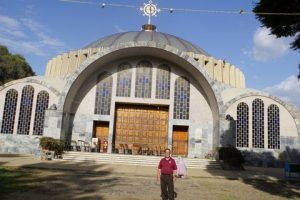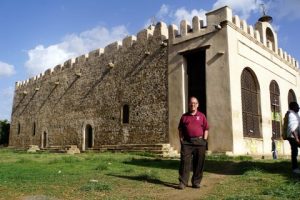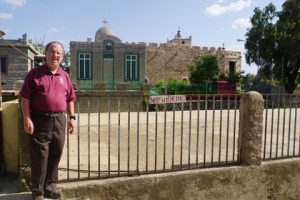We covered 3000 years of history today, all within 60 miles of Aksum, demonstrating the importance of the city in Ethiopian religion, politics, and civilization.
The first site was the city of Yeha, which means first city. The ride, mostly on a Chinese-built highway, ended with a dirt 5K road that took us into a small village, constructing the connector to the highway along with a high school using, among other things, camels to transport debris.

The largest church in Ethiopia, St. Mary of Zion was built near the site of the 4th century church of the same name that was the first in the country. Haile Selassie built it in the 1960s. It can accommodate half a million people. I can hear the mass already–it’s five am–and it will last up to 7 hours.
There were two relics being reconstructed and excavated by a German archeological firm that is an arm of the German federal government. One ruin is a palace dating from the 8th century, but the other, the Temple of the Moon, has a counterpart in Yemen, which demonstrates that the early civilization drew on South Arabia, using the Sabean script. The temple, with 3m limestone blocks resting nicely on one another has partially stood the test of time. When the country became Christian, one of the 9 Syrian missionaries who came in the 6th century to develop what became Orthodox Christianity arrived, they converted the Temple to a Church. Some of the history is recorded through artifacts in a small museum (soon to be replaced, I hope) about the size of a wall tent. There are some stones with Sabean writing which indicates the connection to the Arabian Peninsula. Hence, the claim of Aksum to be the birthplace of Ethiopian civilization.
We came back to Aksum for a tour of Mary of Zion, which is a complex containing the site of the first church ever in Ethiopia. Legend has it that God chose the site, but the 4th century edifice was destroyed first by the Jewish Queen, and then by Ahmed the Left Handed in 1535. Haile Selassie built a modern Church on the site, the third largest dome in the world. One holidays, it can house half a million people. It has loudspeakers, which I heard starting at 5 am for mass, which I understand is experienced standing—and lasts up to 7 hours. The site establishes Aksum as important in the religious history of Ethiopia.

This monastery, built in the 1650s, reflects Portuguese influence. It’s monks are keepers of the Ark of the Covenant.
The centerpiece of the site, and the reason for its importance, is that there is a monastery which houses the Ark of the Covenant. Supposedly, the Queen of Sheba acquired the Ark when she visited Jerusalem, and brought it back to Ethiopia with her. It was given to her son, Menelik I, who started the Solomonic dynasty, which ended ultimately with the overthrow and poisoning of Haile Selassie in 1979.
The monastery makes me eager to get to Gondor (tomorrow) because, built in the 1630s, its design was influenced by the Portuguese who came to assist Ethiopia resist the Muslim invasions. It has a parapet roof, looking like something out of Middle Ages Europe. The monastery provides the monk whose job it is to secure the Ark—he is confined to a building that Emperor Haile Selassi’s wife built. It’s deteriorating, however, and there’s a new building to house it. My guide insisted that the transfer will have to take place at night, since the secret of the Ark is as closely guarded as that of Coca-Cola. Nonetheless, there are 50,000 churches in Ethiopia, and each has a copy of the Ark, called a tabot. On certain holidays, the tabots are brought out and there are processions around the city. They sound impressive.
Two other features of the complex caught my eye, both of them having to do with the political and religious importance of Askum. One is an excellent museum of royal artifacts—clothing and crowns and crosses; the other, continuing the “c” theme, was the coronation throne in front of the monastery, where every monarch was crowned.

This cross marks the mass grave of 200 Italian soldiers killed in a battle nearby that was the largest defeat of a colonial army on the continent. it kept Ethiopia unscrambled during the “Scramble for Africa.” It reads, “we’ll never forget you.” Mussolini didn’t. Forty years later, he occupied Ethiopia, in the first European battle in what became WWII.
Finally, Aksum can put in a bid as an important city in Ethiopian history (and Italian for that matter), because it is near Adwa, where in 1896, an imperialist Italian army was thwarted in its efforts to add Ethiopia to the Italian realm. The badly-beaten Italians buried several hundred soldiers (it was the worst defeat by a colonial power in African history, and kept Ethiopia as the only non-colonized country on the continent) and above the grave erected a cross pledging, “We will never forget you.” In 1936, Mussolini remembered that pledge and conquered Ethiopia. It was the first Western part of World War II, and Ethiopia was the first country liberated. Today, happily, Italians come as archeologists, helping to find more artifacts that fill in the 3000 years of history I saw today.


